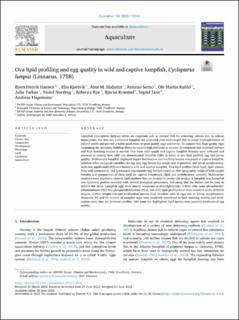| dc.contributor.author | Hansen, Bjørn Henrik | |
| dc.contributor.author | Kjørsvik, Elin | |
| dc.contributor.author | Malzahn, Arne | |
| dc.contributor.author | Sarno, Antonio | |
| dc.contributor.author | Kulild, Ole Martin | |
| dc.contributor.author | Farkas, Julia | |
| dc.contributor.author | Nordtug, Trond | |
| dc.contributor.author | Rye, Rebecca | |
| dc.contributor.author | Kvæstad, Bjarne | |
| dc.contributor.author | Lein, Ingrid | |
| dc.contributor.author | Hagemann, Andreas | |
| dc.date.accessioned | 2022-10-13T07:18:54Z | |
| dc.date.available | 2022-10-13T07:18:54Z | |
| dc.date.created | 2022-09-16T13:34:02Z | |
| dc.date.issued | 2022 | |
| dc.identifier.citation | Aquaculture. 2022, 560 1-11. | |
| dc.identifier.issn | 0044-8486 | |
| dc.identifier.uri | https://hdl.handle.net/11250/3025753 | |
| dc.description.abstract | Lumpfish (Cyclopterus lumpus) serves an important role as cleaner fish for removing salmon lice in salmon aquaculture. For this use, cultivated lumpfish are preferred over wild-caught fish to avoid overexploitation of natural stocks and provide a stable production of good quality eggs and larvae. To support this, high quality eggs containing the necessary building blocks to support high fertilization success, development into a normal embryo and high hatching success is needed. Ova from wild-caught and captive lumpfish females were collected and assessed to identify how wild and domesticated lumpfish differ in terms of ova lipid profiles, egg and larvae quality. Wild-caught lumpfish displayed higher fertilization and hatching success compared to captive lumpfish, whereas other biological variables like egg size, egg/larvae dry weight and respiration, and larval morphometry, were not significantly different between wild and captive lumpfish. Ova lipid profiles (total lipid, lipid classes, fatty acid composition and lipidomics) can separate egg batches based on their geographic origin of wild-caught females and composition of diets used for captive broodstock (lipid and carbohydrate content). Multivariate statistics were applied to identify lipid markers that can be used to predict the quality of lumpfish ova. Lumpfish ova lipidomic profiles covaried with several biological parameters, indicating that the former can be used to predict the latter. Lumpfish eggs were mostly composed of triacylglycerides (TAGs) with some phosphatidylethanolamines (PEs) and phosphatidylcholines (PCs), and their lipid profiles were more sensitive to the different origins, mother weight/size and fertilization success than variables such as eggs size or larvae morphometric measures. PC and PE content of lumpfish eggs were positively correlated to both hatching success and fertilization rates, thus the lipidomic profiles, with some key highlighted lipid species were putative predictors of egg quality. | |
| dc.description.abstract | Ova lipid profiling and egg quality in wild and captive lumpfish, Cyclopterus lumpus (Linnaeus, 1758) | |
| dc.language.iso | eng | |
| dc.title | Ova lipid profiling and egg quality in wild and captive lumpfish, Cyclopterus lumpus (Linnaeus, 1758) | |
| dc.title.alternative | Ova lipid profiling and egg quality in wild and captive lumpfish, Cyclopterus lumpus (Linnaeus, 1758) | |
| dc.type | Peer reviewed | |
| dc.type | Journal article | |
| dc.description.version | publishedVersion | |
| dc.source.pagenumber | 1-11 | |
| dc.source.volume | 560 | |
| dc.source.journal | Aquaculture | |
| dc.identifier.doi | 10.1016/j.aquaculture.2022.738556 | |
| dc.identifier.cristin | 2052501 | |
| dc.relation.project | Fiskeri- og havbruksnæringens forskningsfinansiering: 901562 | |
| dc.relation.project | Fiskeri- og havbruksnæringens forskningsfinansiering: 901561 | |
| dc.relation.project | Norges forskningsråd: 280511 | |
| dc.relation.project | Norges forskningsråd: 245937 | |
| cristin.ispublished | true | |
| cristin.fulltext | original | |
| cristin.qualitycode | 2 | |
